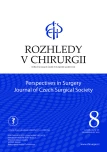Unique robotic vascular surgery procedures
Authors:
P. Štádler; P. Vitásek; P. Matouš; L. Dvořáček
Authors‘ workplace:
Oddělení cévní chirurgie Nemocnice Na Homolce, Praha
Published in:
Rozhl. Chir., 2022, roč. 101, č. 8, s. 375-380.
Category:
Original articles
doi:
https://doi.org/10.33699/PIS.2022.101.8.375–380
Overview
Introduction: Based on their experience with robot-assisted vascular surgery, the authors present some unique types of procedures they have performed in this area.
Methods: From November 2005 to February 2022, a total of 560 robotic vascular procedures were performed, of which 70 were orphan operations, corresponding to 12.5%. The most common was robotic decompression of the coeliac trunk (18 times) in Dunbar syndrome, followed by robotic repair of type II endoleak after stent graft implantation (15 times) and robotic repair of splenic artery aneurysm (11 times). Less common were isolated pelvic artery aneurysm surgery (8 times), aortic thromboenderectomy and abdominal aortic patch repair (8 times) and hybrid surgery (6 times). Completely unique are renal artery reconstruction (2 times), operation of internal mammary artery aneurysm (1 time) in a patient with Marfan syndrome and paracaval biopsy (1 time) in a cancer patient.
Results: In 3 cases (4.2%) the operation had to be converted to open surgery. Twice in the management of splenic artery aneurysm due to flat adhesions in the abdominal cavity and once in the endoleak operation, when due to the very fragile wall of the dilated and pulsating abdominal aortic aneurysm sac, we considered manipulation with robotic instruments to be highly risky. There was zero mortality in this cohort; one patient had to undergo laparoscopic diaphragm repair for diaphragmatic hernia at another institution after deliberation of the coeliac trunk and in one case open surgery was needed for persistent endoleak.
Conclusion: The use of the robotic system can be beneficial also in less frequent procedures, offering the patients all the advantages of robotic surgery. However, the need of extensive experience in robotic surgery should be emphasized because these operations are rare and perfect anatomical knowledge of the area is necessary.
Keywords:
robotic surgery – robotic vascular surgery – minimally invasive vascular surgery
Sources
1. Foertsch T, Koch A, Singer H, et al. Celiac trunk compression syndrome requiring surgery in 3 adolescent patients. J Pediatr Surg. 2007;42:709−713. doi: 10.1016/j. jpedsurg.2006.12.049.
2. Thoolen SJ, van der Vliet WJ, Kent TS, et al. Technique and outcomes of robot-assisted median arcuate ligament release for celiac artery compression syndrome. J Vasc Surg. 2015;61:1278−1284. doi: 10.1016/j.jvs.2014.10.084.
3. Lin JC, Eun D, Shrivastava A, et al. Total robotic ligation of inferior mesenteric artery for type II endoleak after endovascular aneurysm repair. Ann Vasc Surg. 2009;23:255. doi: 10.1016/j. avsg.2008.02.019.
4. Stádler P, Dvoracek L, Vitasek P, et al. Robotic vascular surgery, 150 cases. Int J Med Robot. 2010;6:394−398. doi: 10.1002/rcs.344.
5. Ossola P, Mascioli F, Coletta D. Laparoscopic and robotic surgery for splenic artery aneurysm: A systematic review. Ann Vasc Surg. 2020;68:527−535. doi: 10.1016/j. avsg.2020.05.037.
6. Štádler P, Šebesta P, Vitásek P, et al. A modified technique of transperitoneal direct approach for totally laparoscopic aortoiliac surgery. Eur J Vasc Endovasc Surg. 2006;3:266−269. doi: 10.1016/j. ejvs.2006.01.023.
7. Colvard B, Georg Y, Lejay A, et al. Total robotic iliac aneurysm repair with preservation of the internal iliac artery using sutureless vascular anastomosis. J Vasc Surg Cases Innov Tech. 2019;5(3):218−224. doi: 10.1016/j.jvscit.2019.01.001.
8. Štádler P, Dvořáček L, Vitásek P, et al. Is robotic surgery appropriate for vascular procedures? Report of 100 aortoiliac cases. Eur J Vas Endovasc Surg. 2008;36:401−404. doi: 10.1016/j.ejvs.2008.06.028.
9. Štádler P, Vitásek P, Matouš P, et al. Hybridní roboticky asistovaná operace, aortobifemorální bypass s rekonstrukcí kýly v jizvě. Rozhl Chir. 2008;11:590−592. Available at: www: https://pubmed.ncbi. nlm.nih.gov/19209512/.
10. Giulianotti PC, Bianco FM, Addeo P, et al. Robot-assisted laparoscopic repair of renal artery aneurysm. J Vasc Surg. 2010;51(4):842−849. doi: 10.1016/j. jvs.2009.10.104.
11. Bonatti J, Vetrovec G, Riga C, et al. Robotic technology in cardiovascular medicine. Nat Rev Cardiol. 2014;11:266−275. doi: 10.1038/nrcardio.2014.23.
12. Bokhari MB, Patel CB, Ramos-Valadez DI, et al. Learning curve for robotic-assisted laparoscopic colorectal surgery. Surg Endosc. 2011;25:855−860. doi: 10.1007/ s00464-010-1281-x.
13. Feuer G, Hernandez P, Barker J. Surgical technique enhances the efficiency of robotic hysterectomy. Int J Med Robot. 2011;7:1−6. doi: 10.1002/rcs.361.
14. Patel VR, Abdul-Muhsin HM, Schatloff O, et al. Critical review of ‚pentafecta‘ outcomes after robot-assisted laparoscopic prostatectomy in high-volume centres. BJU Int. 2011;108:1007−1017. doi: 10.1111/j.1464-410X.2011.10521.x.
15. Park YM, Lee WJ, Lee JG, et al. Transoral robotic surgery (TORS) in laryngeal and hypopharyngeal cancer. J Laparoendosc Adv Surg Tech. 2009;19:361−368. doi: 10.1089/lap.2008.0320.
16. Lang JE, Mannava S, Floyd AJ, et al. Robotic systems in orthopaedic surgery. J Bone Joint Surg Br. 2011;93:1296−1299. doi: 10.1302/0301-620X.93B10.27418.
17. Kaouk JH, Goel RK, Haber GP, et al. Robotic single-port transumbilical surgery in humans: initial report. BJU Int. 2009;103:366−369. doi: 10.1111/j. 1464-410X.2008.07949.x.
Labels
Surgery Orthopaedics Trauma surgeryArticle was published in
Perspectives in Surgery

2022 Issue 8
Most read in this issue
- Complications and pitfalls of endovenous laser therapy for varicose veins of lower extremities
- Unique robotic vascular surgery procedures
- Endovenous laser ablation of saphenous veins – favorable clinical results confirm theoretical advantages of the 1940nm diode laser
- Efficacy and safety of urgent carotid endarterectomy in patients with acute ischemic stroke
